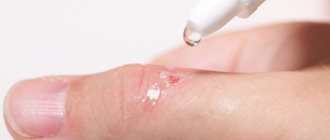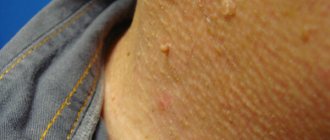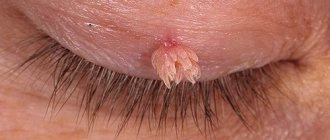Causes of papillomas
It is believed that up to 70% of the entire population of the planet is infected with the human papillomavirus. Often, based on the results of the analysis, it becomes clear that a person is infected with 20 strains of the virus at once. But often the virus does not manifest itself for a long time, especially if the person has good immunity.
A non-specialist is unlikely to determine the type of neoplasm on the skin “by eye”
Infection with any of the HPV strains most often occurs through direct contact with a carrier of the virus, in which the pathogen can penetrate microtraumas on the skin and mucous membranes. The neoplasm forms directly at the site where the virus enters the body. The anogenital form of the disease is transmitted during sexual intercourse, in this case papules form in the folds of the skin of the perineum, on the mucous membranes of the vagina and cervix, in the rectum, urethra and bladder, and in men - on the head of the penis. On the outside, genital warts are mainly formed, and on the internal organs - flat papillomas. The oral cavity can be infected in a similar way. In this case, laryngeal papillomatosis occurs, affecting the mucous membranes of the mouth and throat.
A newborn can become infected with HPV from the mother during passage through the birth canal. In this case, the child most often develops anogenital papillomatosis, the strain of which is the most aggressive, or laryngeal, which can significantly damage the child’s vocal apparatus in the future and can even be life-threatening in severe cases due to airway obstruction.
However, to become infected with HPV, it is not necessary to have direct contact with the carrier. The virus can exist for some time outside the host’s body and be transmitted through household objects or in public places. Simply put, sometimes it is enough to hold on to the handrail in public transport and then touch your face, so that in a year or two a new growth will appear in that place.
Since the incubation period of the papillomavirus is quite long, several months or even years may pass from the moment of infection to the appearance of clinical signs. Usually the virus is activated and begins to manifest itself in the form of neoplasms when immunity decreases. That is why treatment should include not only the removal of visible manifestations of HPV, but also systemic immune therapy.
How to choose the right product
When choosing a specific drug, it is important to take into account the location of the papilloma, the exact cause of origin and the sensitivity of the skin. To decide on a treatment regimen, it is recommended to consult a specialist, since there are other skin diseases similar to papillomatosis.
Correctly chosen therapy will help to easily remove the formation without causing significant harm to the body. Tumors that are located on the mucous membranes require special attention. When choosing remedies in this case, it is necessary to take into account the sensitivity of this part of the body in order to avoid negative consequences.
Independent selection of drugs is undesirable, but is acceptable if you have personal knowledge and skills that help establish the benignity of the neoplasm.
Types of tumors caused by HPV
Not all clinical manifestations of papillomatosis are the same. Today, about 90 HPV strains have been typed and correlated with certain types of neoplasms. Based on the external manifestations of the disease, the following types of papillomas are distinguished:
- plantar papillomas, often called warts;
- simple, or vulgar, papillomas;
- flat papillomas;
- genital warts;
- filamentous papillomas.
Even a doctor cannot always make an accurate diagnosis based on appearance
Plantar warts
As the name suggests, plantar warts form on the skin of the feet and are characterized by internal growth, which distinguishes them from other types of neoplasms. They are usually solitary, but if left untreated they can reach impressive sizes, causing considerable discomfort.
Vulgar papillomas
Vulgar papillomas are also often called warts in everyday life. They grow from a small tubercle, gradually enlarging and darkening due to keratinization, and can merge with each other into formations of an indeterminate shape. Papillomas of this type are most often localized on the skin of the hands, less often on the knees, face, neck, and back. Like plantar pain, they can go away on their own.
Flat papillomas
Flat papillomas rise slightly above the skin, and their surface has a nodular structure. These neoplasms are not subject to keratinization (keratinization) of the surface, so they usually retain the color of healthy tissue or become slightly darker. They can appear on the face in the eye area and on the chin, as well as on the lower legs, arms, and back. A common symptom of vulgar papillomas is itching. Such neoplasms do not go away on their own, and an accurate diagnosis must be made by a doctor.
Condylomas acuminata
Genital warts are similar in appearance to cauliflower. Single neoplasms grow on a thin stalk, gradually merging with each other into large growths. Condylomas are localized in the anogenital area:
- on the external and internal genital organs;
- outside and inside the anus;
- in the perianal fold;
- in the urethra and bladder.
These neoplasms are precancerous and therefore must be removed, followed by subsequent therapy based on test results. Suffice it to say that in almost 80% of cases, cervical cancer is detected by this type of human papillomavirus.
Filiform papillomas
Filiform papillomas, otherwise called acrochords, grow on a thin stalk, which makes them easy to accidentally tear off, and are predominantly single, less often found in groups. Their main locations are the face in the area of the eyes and nose, inguinal folds, axillary areas and under the breasts in women. They usually have an oblong, elastic shape without keratinization. Rubbing with clothing can cause discomfort and damage. Acrochords cause mainly aesthetic discomfort and are susceptible to malignancy in rare cases.
An accurate diagnosis can be established using laboratory methods for studying tumors
Skin formations of non-viral origin
Fibroepithelial polyps are a common benign tumor, usually called “papilloma”.
Who it occurs in: middle-aged and elderly people, menopausal and postmenopausal women, pregnant women.
Half of the total population has at least one fibroepithelial polyp.
What they look like:
A 1 mm to 1 cm pedunculated nodule is usually skin-colored but may be yellowish or brown. Soft, mobile.
Can such “papillomas” cause cancer? No, they are not precancer. They are dangerous because when injured they can become inflamed and fester. Discomfort, cosmetic defect, but do not pose a serious threat to life.
Can be removed using minimally invasive (low-traumatic) methods.
Seborrheic keratosis
Who it occurs in: most often in men and women in middle and old age.
What it looks like: papules (tubercles) of pink, yellow-gray, brown, black color, often with a rough surface, of various shapes and sizes from a few millimeters to several centimeters. Can be located anywhere except the palms and soles. They look quite impressive, given the large size and multi-colored formations.
Can seborrheic keratosis develop into cancer? No.
Can be removed using minimally invasive methods.
Also included in the group of “papillomas” are various nevi (moles) - intradermal, warty and other formations that have an elevation above the surface and a “leg”. The issue of removal is decided by a specialist. For some nevi, only surgical excision is possible.
Diagnosis of papillomas
No matter how much you would like to get rid of annoying papilloma quickly and at home, or even better - with the help of some folk remedies, do not rush! Self-selecting procedures can lead to disastrous results. Be sure to visit your local clinic.
In a paid clinic, for your money, they will cut/burn/freeze anything for you without any questions asked, but there is no guarantee of an accurate diagnosis, and therefore the absence of undesirable consequences.
Only a qualified specialist can make an accurate diagnosis and prescribe appropriate treatment. Be sure to take the tests prescribed by your doctor before getting rid of tumors. First of all, you need to get advice:
- a gynecologist or urologist if tumors appear in the perineal area;
- an otolaryngologist if papillomatosis of the mucous membranes of the mouth or throat is suspected;
- a dermatologist - in all other cases.
Based on the results of the clinical examination, the doctor, if necessary, may prescribe:
- collection of cells for cytological examination;
- tissue sampling for histology;
- scraping for PCR analysis;
- collecting material for the daijin test.
All these methods, in one way or another, make it possible to determine the risk of developing cancer. After removing the tumors by any method, it will no longer be possible to determine this indicator. This increases the likelihood of adverse consequences.
Panavir for papillomas on the neck
Panavir is a herbal antiviral agent.
It contains nightshade polysaccharides.
This is the scientific name for potato.
The same thing you eat for lunch.
Panavir is used in different ways.
It is available in the form of a gel, rectal suppositories, vaginal suppositories and an intravenous solution.
According to the manufacturers, its mechanism of action is based on:
- stimulation of the formation of endogenous interferon
- increasing nonspecific resistance of the body
The list of indications for the use of potato extract includes a large number of viral diseases.
Including Panavir can be used for papillomavirus infection.
It is noted that it is used only as part of complex therapy.
This statement alone indicates that the drug is ineffective against HPV.
Because drugs that actually work can also be used in monotherapy.
They do not need any additional medications.
Complex therapy involves the use of a truly effective drug, and in addition to it - Panavir.
As a result, the effective drug will work, and you will not even notice that Panavir turned out to be useless.
Its effect on human papillomavirus infection is unlikely.
Papillomas on the neck are unlikely to fall off after using Panavir.
Chemical destruction
It is carried out using special liquid preparations based on acid or creams containing alkali. Such drugs are sold in pharmacies as prescribed by a doctor.
This method can be used to remove only single vulgar papillomas (warts) on the hands.
However, the slightest inaccuracy in the use of chemotherapy can lead to burns of healthy tissue or incomplete removal of the tumor. The use of such products is painful, time-consuming, does not provide a guaranteed result and can lead to the formation of unsightly scars at the site of the tumor.
When using chemicals to combat tumors, special precision is required
Cryodestruction
A long-established and well-proven method of removing tumors using exposure to extremely low temperatures, in which the affected area is exposed to liquid nitrogen or other refrigerant for a short time.
The application of the refrigerant itself does not require preliminary anesthesia, because The application is painless, although the patient may feel a slight tingling or burning sensation. However, after the operation, during the “unfreezing” of the tissues, acute pain occurs, which can last up to a day. This is normal.
After a few hours, redness and swelling form around the injury, and a day later a subcutaneous blister filled with fluid forms. The rehabilitation period lasts a week, during which the swelling and hyperemia disappear, and the bladder breaks on its own. After this, it is necessary to apply an antiseptic drug prescribed by a specialist.
The death of tissue under the scab continues for three weeks, which ensures reliable destruction of infected tissue. Wound healing occurs in 1.5 months, and the mark completely disappears in six months, during which it is necessary to protect the skin from the sun and mechanical stress.
The method is successfully used to remove papillomas on the body, in the oral cavity and for the treatment of the cervix. But to remove tumors on the face and intimate area, it is better to use another method. In the first case - due to swelling and hyperemia, in the second - due to increased pain sensitivity of the genital area.
An effective cure for papillomas on the neck
At present, specific drugs that can destroy papillomavirus have not yet been developed.
But there are drugs that remove the papilloma itself.
They are not used in tablets, but only in topical forms.
These are mainly not ointments and creams, but solutions.
There are drugs that allow you to remove papillomas on the neck of a man or woman using the following methods:
- chemical
- cytotoxic
The first method involves the use of drugs that cause a chemical burn to the skin.
This burn develops only in the place where the papilloma is affected.
It is local, and if the drug is used correctly, the surrounding tissues are almost not affected.
However, such means have a number of disadvantages.
They are not always effective.
Can only be used under the supervision of a specialist.
Moreover, the neck is not the most accessible location for papilloma for self-removal.
You can apply the drug to healthy tissue, and then the affected area will be too large.
If you expose your skin to caustic chemicals for too long, you may experience a deep burn.
This will lead to scar formation.
It will look even worse than the papilloma itself.
The most common medicine for chemical removal of papillomas is called Solcoderm.
It contains several acids, including acetic, nitric, oxalic, and lactic.
A cytotoxic method is also used to remove papillomas on the neck.
The drug is used for a long time and acts gradually.
This approach is safer, although not always effective.
Remove papillomas on the neck at home
Sometimes patients ask whether it is possible to remove papillomas on the neck at home.
Theoretically this is possible.
Even if you don’t have a laser or radio wave device at home.
But the papilloma can be cut off with scissors or pulled out with tweezers.
But this is fraught with negative consequences.
Therefore, it is better not to use such radical measures.
As a result, the wound may become infected or large scars may form.
Not to mention that the procedure will be painful.
Therefore, real ways to remove papillomas at home come down to three methods:
- chemical removal
- cryodestruction using home cryosystems
- use of cytotoxic drugs
You can cauterize papilloma on the neck using Solcoderm.
This solution removes fluid from cells and provokes tissue necrosis.
First, the skin is treated with alcohol.
Then, using a special applicator, the product is applied to the skin.
A glass capillary can also be used.
It comes included.
But chemical removal has a number of difficulties.
Often, if a person does this on his own, he gets chemical burns to the skin.
But even if Solcoderm does not get on healthy skin, you can overdo it and pour too much solution on the papilloma.
As a result of deep necrosis, a large scar will appear.
Apply exactly as much solution as the skin absorbs.
Within 5 minutes Solcoderm is on its surface.
Then the solution must be washed off.
This product can only remove small formations.
It is likely that you will need multiple treatments.
The criterion for the effectiveness of leather treatment is the change in its color to gray or yellow.
Over time, the papilloma will turn brown.
A scab will form there and will fall off to reveal healthy skin.
Treatment of red papillomas on the neck can be carried out using liquid nitrogen.
The Wartner Cryo system is available for purchase in pharmacies.
It is enough not for one, but for many papillomas or warts.
Briefly, the method of application can be described as follows: you apply an applicator to the skin, into which liquid nitrogen is pumped.
Hold for a few seconds.
After this, the tissue cools and the papilloma dies.
True, you can use Wartner Cryo only at your own peril and risk.
Firstly, this product is not used on sensitive areas of the skin.
These include the neck area.
Secondly, Wartner Cryo is designed to remove warts, not papillomas.
Third, you won't be able to accurately calculate how many seconds you need to hold the applicator.
Because in the instructions the recommendation is given only for removing warts.
If you overdo it, you can get severe frostbite and a large scar on the skin.
Therefore, although theoretically this method of home removal of papillomas on the neck is possible, in practice it is dangerous and not always effective.
Finally, the third effective method is cytotoxic.
The drug podophyllotoxin is usually used.
It is of plant origin.
It causes necrotic changes in tissues when applied topically.
Effects of the drug:
- cytostatic (blocks cell division)
- cauterizing
- necrotizing
Podophyllotoxin is used for 3 days.
It is applied to the papilloma.
Then they take a break for 4 days.
Usually after use, after a few days, redness is observed in the affected area, and swelling may form.
After the break, the course is repeated - another 3 days of use, and another 4 days break.
You need to repeat it until the papilloma disappears.
But you can’t do more than 5 courses.
If it was not possible to remove the formation after 5 times, you need to use another, more effective method.
The drug has disadvantages:
- not always effective
- causes skin burns
- May get into eyes if used carelessly
- a small amount of podophyllotoxin is absorbed into the blood
Some patients use folk remedies.
For example:
- Castor oil
- aloe
- celandine
- vinegar
- essential oils
All these methods are ineffective in the vast majority of cases.
They only have a negative effect on the condition of the skin.
However, papilloma usually does not disappear after treatment.
Radio wave coagulation
Removal of tumors with a radioknife occurs under the influence of directed high-frequency radiation, during which the affected tissue evaporates. The radiotherapy device has several electrodes of various shapes and purposes, which the doctor selects depending on the form of the tumor. The most widely used device in our country is the Surgitron device.
The procedure is performed under local anesthesia in the form of an injection. With this method, papillomas are removed quickly, without damaging healthy tissue, leaving almost no traces. There is no rehabilitation period here, but there are many contraindications to the use of this method. Radioknife is contraindicated for:
- exacerbation of chronic diseases;
- acute inflammatory processes;
- diabetes mellitus;
- pregnancy and lactation;
- presence of a pacemaker;
- oncological diseases of any location.
Radio wave treatment should not be used if there is a possibility of malignancy of papillomas. But in the absence of such, the method is successfully used on any part of the body. According to patients, the most unpleasant thing about this procedure is the anesthetic injection.
Laser coagulation
The modern non-contact method of removing tumors using a laser has become widespread not so long ago. Experts say that it is absolutely painless and low-traumatic, because... infected tissues evaporate without harming healthy ones. The procedure takes a few minutes, and the rehabilitation period lasts 2 weeks, during which you should refrain from swimming in the pool and open water, and avoid temperature changes and the sun.
The method can cause side effects such as prolonged skin redness and swelling; in case of thyroid problems, keloid scars can form. There are many contraindications for this type of treatment:
- diabetes;
- acute inflammatory processes;
- epilepsy;
- disorders of the endocrine and immune systems;
- photoderomatosis;
- thrombocytopenia and others.
According to patients, the procedure is very unpleasant and painful, and during the process “you can smell the smell of burnt meat.” In addition, healing takes a long time and relapses are possible.
Folk remedies
In folk medicine, there are many recipes that have antiviral activity.
Potato juice
It is recommended to drink 100-200 ml of potato juice every morning. This folk remedy can also be applied to papilloma.
It helps strengthen the immune system and improve the condition of the body.
Celandine
For treatment, juice or tincture of celandine is used. The plant is rich in acid, which destroys papilloma cells.
To do this, celandine juice should be applied pointwise every 2 days, avoiding healthy skin.
Iodine, aspirin, boric acid
To prepare the product, mix 3 g of iodine with the same amount of aspirin, alcohol and boric acid. This composition should be regularly applied to the papilloma.
The product cannot be used on eyelids and mucous membranes.
Garlic
Recipe 1:
- Chop the garlic and add to a small amount of baby cream.
- Apply the paste to the formation and secure with a gauze bandage.
- Wash off after 2 hours.
- Repeat 2 times a week.
When the papilloma darkens and falls off, it is recommended to apply the product once every 3 days for another month.
Recipe 2:
- Take equal amounts of garlic and linden or flower honey.
- Chop the garlic and mix with the beekeeping product.
- Apply the composition to the papilloma for 20 minutes.
- Rinse off with warm water.
- Repeat the procedure 2 times a day until the tumor is rejected.
Recipe 3:
- Grind a whole head of garlic on a grater.
- Add 2 tbsp. l. pork fat, mix.
- Apply to papillomas 2 times a day and leave for 3 hours.
- Secure the composition with gauze or bandage.
The effect can be observed after 2-3 days - dead cells will disappear, the papilloma will begin to shrink.
Ointments and creams using garlic should not be used on mucous membranes and genitals. Otherwise, the mixture will cause burning, swelling and irritation.
If a month after the start of therapy no effect is observed and the growth has not decreased, it is recommended to consult a specialist.
Electrocoagulation
With any method of removing papillomas, there is a certain rehabilitation period.
It is used to remove small papillomas. Since the essence of the method is the thermal destruction of the affected tissue, the method is popularly called “cauterization.” A heated electrode is used to touch the neoplasm and coagulate it along with the vessels, resulting in a pinpoint burn that becomes covered with a dark crust within an hour. In the case of single papillomas, local anesthesia is used, but in the case of multiple small tumors this is inappropriate.
The rehabilitation period lasts about a week, during which the redness and swelling disappear and the dark crusts disappear. At this time, it is recommended to protect yourself from the sun and treat your skin with an antiseptic.
The use of this method is possible for any location of tumors, and patient reviews indicate its reliability. While the price for removing one papilloma is very reasonable, removing multiple tumors will cost a pretty penny.
How to treat warts and papillomas?
There are destructive methods, therapeutic interventions and traditional methods. Since warts are considered neoplasms, they can be removed artificially. The technology is radical, but fail-safe. There are several types of operations to remove papillomas:
- Cryotherapy
- Electrotherapy
- Laser removal
- Surgery
- Electroradiosurgery
- Chemical method
Therapy depends on many factors, which are studied in detail by a dermatologist. The negative side of destructive intervention is the elimination of external manifestations of the disease. Warts usually appear due to the action of a virus, so cosmetic solutions will not relieve you of the pathology, but may lead to a relapse.
As for drug therapy, all immune drugs are divided into two categories - systemic and local. The idea is to boost immunity - the body itself will cope with the problem that has arisen. There are also known drugs belonging to the group of interferons (proteins with anti-infective characteristics). Occasionally, apoptosis inducers are prescribed, the purpose of which is to program the destruction of HPV cells that have undergone a viral attack. Of the folk remedies, onion and garlic juices, as well as alcohol tinctures based on celandine, are considered the most effective.











